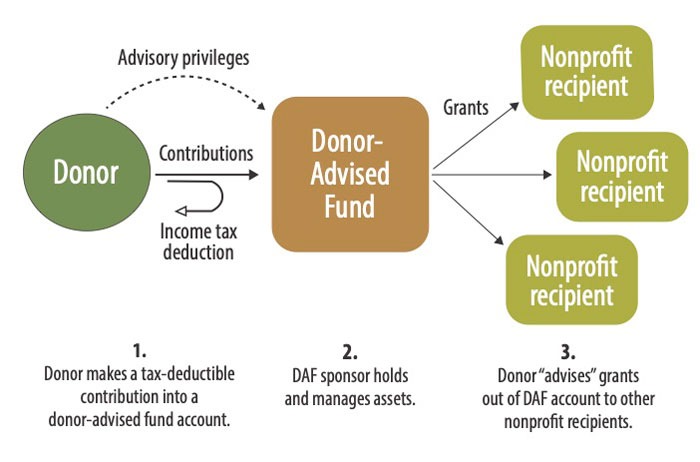
This is the third of a four-part series from the winter 2019 edition of the Nonprofit Quarterly, addressing the decline of small and medium-sized donor households. NPQ considers this issue an urgent matter for the entire sector.
In 2018, a study by philanthropy and charitable-giving expert Dr. Patrick Rooney of the Lilly Family School of Philanthropy confirmed that while dollar levels of giving overall in the United States are relatively stable, the number of households contributing to that pool of philanthropic capital is shrinking at the lower income levels.1 This phenomenon is sometimes called “dollars up, donors down,” and has been noted by certain large institutions for some time.2
Now, a new report by Chelsea Clark, Xiao Han, and Una Osili, a research team also at the Lilly Family School of Philanthropy, has further clarified Dr. Rooney’s findings.3 Changes to the Giving Landscape, which admittedly is focused only on certain categories of giving, gets even more exact about the nature and degree of the reduction in the number of U.S. households making charitable gifts—which shrank by 13 percent, or 20 million households—between 2000 and 2016. The report explains:
From 2000 to 2008, the share of U.S. households donating to charity held relatively steady, dropping only from 66.22% to 65.41%. However, 2010 marked a turning point, as the share who gave declined to 61.11% following the Great Recession. The overall giving incidence was only 53.09% in 2016, the most recent year of data available. This represents a significant decrease of about 20 million donor households since 2000.4
The trajectory of that decline began around 2010, after the end of the recession, and that should be cause for alarm for small to midsized nonprofits. (See Figure 1.) It should also be cause for alarm for anyone concerned about the integrity of our democracy.
Fig. 1: Fraction of donor households over time.

That the recession was at least in some large part implicated in the decline is reinforced by some of the other stark findings in the report:
The Great Recession (December 2007–June 2009) was the most significant economic downturn in America since the Great Depression. As such, it influenced American households in many ways. Real GDP fell by 3.1 percentage points, real personal income per capita fell by 8.3 percentage points, and the unemployment rate increased from 4.6 percent to 9.3 percent during the Great Recession (Moffitt, 2013). Following the Great Recession, wages, income, and employment rates were slow to recover, especially for certain demographic groups.5
Building on this, the report has more exactly identified the kinds of households that stopped giving—at least through 2016. They include, most markedly:
- those with less than a high school education,
- those who make less than $50,000 per year, and
- those who have less than $50,000 in wealth.
In an interview for this article, Una Osili, a lead researcher on the study, observed that this pretty much conforms to the populations that were most seriously left behind in the recovery, which further widened the wealth gap in the country. But we already know this; any number of studies have documented the perversity of this “recovery” caused by and benefiting most the richest in the country: 6
In relative terms, declines in net worth were most pronounced at the bottom of the distribution. While households at the 95th percentile of net worth were worth roughly the same in 2011 and 2003 . . . households at the median in 2011 had only 55 percent of the 2003 median net worth and those at the 25th percentile had only 15.3 percent of those at the 25th percentile in 2003. Moreover, the relative decline in net worth was smaller at higher percentiles than at lower percentiles.7
This calls into question one of the mainstays of predictive indicators on giving in the relationship between GDP and giving rates. While it is generally acknowledged that giving rates are affected by local and national economic trends, in this case the number of households continued to fall apace even after the nation’s primary economic indicators were well into “recovery.”
And indeed, the demographic that has evidently stopped giving is arguably more marginalized—not only economically but also politically—than other groups; so, where after past economic shocks there was a sense that there would be some effort to lift all boats, that has not been true with this recession. It has been the exact opposite. In fact, the federal government has reserved any sort of charitable deduction for itemizers who are not located at the lower echelons of income; this perversely provides an incentive for the rich to give, but not the rest of us, thus weighing in very much on the wrong side of current giving trends.
“So what?” some might say. “Let the rich give—they can afford it.” But when the rich give, they also choose which approaches are valid and which are not—and yet one more sector of society is increasingly unitarily shaped by higher-income individuals.
So, what is the point I am trying to make? In its discussion section, the Lilly School’s report cites a study that concluded that the propensity for generosity is “affected by an individual’s feelings of optimism about the future.” The report continues: “This is something that is unique to each generation and relates to how each generation reacts to social and economic trends—and how each generation expects the trends to continue into the future. Taking this valuable insight into consideration, understanding how Americans experienced the Great Recession is essential to the future of American philanthropy.”8
It is hardly a significant leap, then, to speculate that there may be a portion of the population of this country that has disengaged from that sense of optimism or faith that a donation to a nonprofit will somehow make things work better for them or for those around them.
If we are seeing disengagement for reasons of a lack of optimism, that is more than a fundraising problem—it may be a problem of the frames within which nonprofits and philanthropy work. That is, are our programs aimed at building shared wealth and community sustainability founded on plural ownership of political and economic capital? Or are we falling ever farther into a set of relationships with corporations whose extractive tendencies wring every drop of available wealth from working people, only to turn around and, in a great show of largesse, “donate” some of it back to those very same workers?
Sign up for our free newsletters
Subscribe to NPQ's newsletters to have our top stories delivered directly to your inbox.
By signing up, you agree to our privacy policy and terms of use, and to receive messages from NPQ and our partners.
Do we imagine that working people want to labor for the periodic charitable subsidy rather than a stake of their own?
Part of what we must come to terms with in this sector is the notion, which may be increasingly widely held, that nonprofits are compliant handmaidens to an unjust system. If that is so, then perhaps we could expect to see less giving by those falling ever farther behind—not because people are becoming less generous, but because they are becoming less trusting that the sector will put their ideas and interests first in designing approaches to problems caused by those giving hundreds of thousands of times what individuals may be able to part with. Are megadonors looking for justice or, after the fact, whitewashing-apology alms that fall far short of the injury caused?
Imagine the impression upon regular donors, for instance, made by the billions of dollars tech firms are now throwing at nonprofits addressing the affordable housing crisis in California and Seattle. At some level, we have to imagine that the resentment caused by being heedlessly displaced and underpaid by Amazon might cause individual donors to give less to groups that receive funding from that corporation. Or do we think they cannot connect those particular dots? At the very least, we may be able to imagine a crowding-out effect of corporate riches on the odd fifty-dollar donation. In the end, it comes down to whose voice and definitional power are being amplified through the work done by a nonprofit.
And that is about democracy.
But while we have talked above about the possibility of increasingly disenfranchised people disengaging from nonprofits, there is a more proven and long-term trend of people losing faith in all institutions—including those in the nonprofit sector. As Osili pointed out, we know from the General Social Survey of adults and the Monitoring the Future Survey of twelfth graders that there has been a steady decline in that respect since 1974.9 According to Osili, millennial giving rates have been growing more slowly than was anticipated—and despite the fact that research has long indicated that this generation requires different types of engagement to create the bond required to make a long-term giver, we do not see much activity by nonprofits themselves to attend to an increasingly less vibrant relationship between nonprofits and their donors.
We might also point to the increasingly less vibrant relationship between people and many nonprofit organizations. People are asked to volunteer and give in different ways than in the past—through the corporation that employs them or through a volunteer broker or the United Way (which can often be inappropriate and outright flat-footed)—and nonprofits have adapted, severing (to some extent) the direct relationships that build over time to provide capital of many types to community groups.
An illustration of the potential distance created can be found in a recent paper, “Understanding Donor-Advised Funds: How Grants Flow During Recessions,” by H. Daniel Heist and Danielle Vance-McMullen.10 (See Figure 2.) And while the people establishing donor-advised funds are probably a different demographic from those falling away from giving more generally, the distancing by the intermediation dynamic is often the same.
Figure 2: Three Basic Donor-Advised-Fund Activities

“Where are the platforms for engagement that will be required? How will ‘habits of giving’ be established?” asks Osili.
Indeed, if the relationship between nonprofit and donor is not vibrant and multifaceted, the falloff of donors may be entirely predictable. A paper called “Developing Donor Relationships: The Role of the Breadth of Giving” addresses the resilience built through multiple points of contribution, concluding that “donors with a higher level of donation variety of their past gifts are more likely to give in the future and, conditional on the gift being made, are likely to give more than donors with a lower degree of donation variety.”11 Additionally, states the paper,
we present empirical evidence that donation variety can also change a donor’s responsiveness to the changes in macroeconomic environment. We find that donors with a higher degree of donation variety are less responsive to negative changes in the macroeconomic condition, making them less risky because their donation patterns have lower volatility with external shocks.12
Is What We Need a “Culture of Philanthropy,” or Is That Frame Just Wrong?
The phrase “culture of philanthropy” has been used over the past decade to describe nonprofits that are attentive to promoting meaningful engagement with the organization’s mission among the whole of their community. The engagement is inclusive of donors. It has tended to be applied where staff in various roles get involved in raising the financial capital the organization needs.
But, more generally, perhaps we need to interrogate our frameworks—the ones that assume that charity is legitimate or justifiable as the primary intention of this sector over, say, common cause for the promotion of justice and equity or similar shared community values. In the latter model, multiple forms of capital are needed in unpredictable times, so individuals must be kept engaged. In the former model, donors are sometimes treated as being valued for just one type of capital. And if, per the former model, this is true, organizations might not just spend more time on high rather than lower donors—they might also be less likely to do the things that might convince even (or even especially) the most modest of donors that their thoughts and ideas are being taken into serious account.
As Clark, Han, and Osili remark, “At a time when needs continue to multiply, the importance of thinking anew about how to deepen and expand our relationships with past and future donors becomes more critical. To meet the complex challenges of such factors as changing tax laws, shifting demographics, and economic downturns, to name a few, we need to develop strategies for 21st century philanthropy.”13
To conclude, we would point to systems that do offer donors multiple points of engagement with their various types of capital—such as in Planned Parenthood and reproductive rights in general, where the “we are in common cause of a critical nature” proposition shines through. Not every organization has such an evident burning platform, but the principle of the endeavor, which includes the message that each activist is necessary for his or her holistic engagement, comes through as the core of the organization’s identity. Part of the problem, then, may be in the continual handing off of the relationship with supporters to various intermediaries—as if what is built through those interactions is not real capital, but the other part, now being addressed quite publicly via the use of philanthropy to prop up the wealth divide and an elite plutocracy. This requires longer-term attention to democracy and economic justice. Immediately, however, passing the universal charitable deduction should be a short-term sector imperative.
Notes
- Patrick M. Rooney, “The Growth in Total Household Giving Is Camouflaging a Decline in Giving by Small and Medium Donors: What Can We Do about It?,” Nonprofit Quarterly 25, no. 3 (Fall 2018): 44–49.
- Nick Hazelrigg, “Larger Donations, Fewer Donors,” Inside Higher Ed, June 20, 2019.
- Chelsea Jacqueline Clark, Xiao Han, and Una O. Osili, Changes to the Giving Landscape (Indianapolis, IN: Indiana University Lilly Family School of Philanthropy at IUPUI, 2019).
- Ibid., 6.
- Ibid., 4.
- See, for example, Fabian T. Pfeffer, Sheldon Danziger, and Robert F. Schoeni, “Wealth Disparities Before and After the Great Recession,” ANNALS of the American Academy of Political and Social Science 650, no. 1 (November 2013): 98–123.
- Ibid., 106.
- Clark, Han, and Osili, Changes to the Giving Landscape, 17.
- See Jean M. Twenge, W. Keith Campbell, and Nathan T. Carter, “Declines in Trust in Others and Confidence in Institutions Among American Adults and Late Adolescents, 1972–2012,” Psychological Science 25, no. 10 (October 2014): 1914–23; and “Confidence in Institutions: Trends in Americans’ Attitudes toward Government, Media, and Business,” Issue Brief, The Associated Press-NORC Center for Public Affairs Research, accessed November 19, 2019.
- Daniel Heist and Danielle Vance-McMullen, “Understanding Donor-Advised Funds: How Grants Flow During Recessions,” Nonprofit and Voluntary Sector Quarterly 48, no. 5 (October 2019): 1066–93.
- Farnoosh Khodakarami, J. Andrew Petersen, and Rajkumar Venkatesan, “Developing Donor Relationships: The Role of the Breadth of Giving, Journal of Marketing 79, no. 4 (July 2015): 89.
- Ibid., 90.
- Clark, Han, and Osili, Changes to the Giving Landscape, 3.











